Report on Developing Personal and Management Skills for Leadership
VerifiedAdded on 2023/06/12
|15
|4032
|260
Report
AI Summary
This report explores the development of personal and management skills, crucial for professional and personal growth. It includes a reflection on leadership and management skills using models like Kolb’s experimental learning cycle and Driscoll's model of reflection. The report also explains transferable skills such as supportive communication, motivation, empowerment, conflict management, and team effectiveness, referencing relevant theories. It discusses how these skills can be applied within an organization like Sainsbury’s to enhance employee performance and productivity, focusing on practical applications and benefits for organizational success.
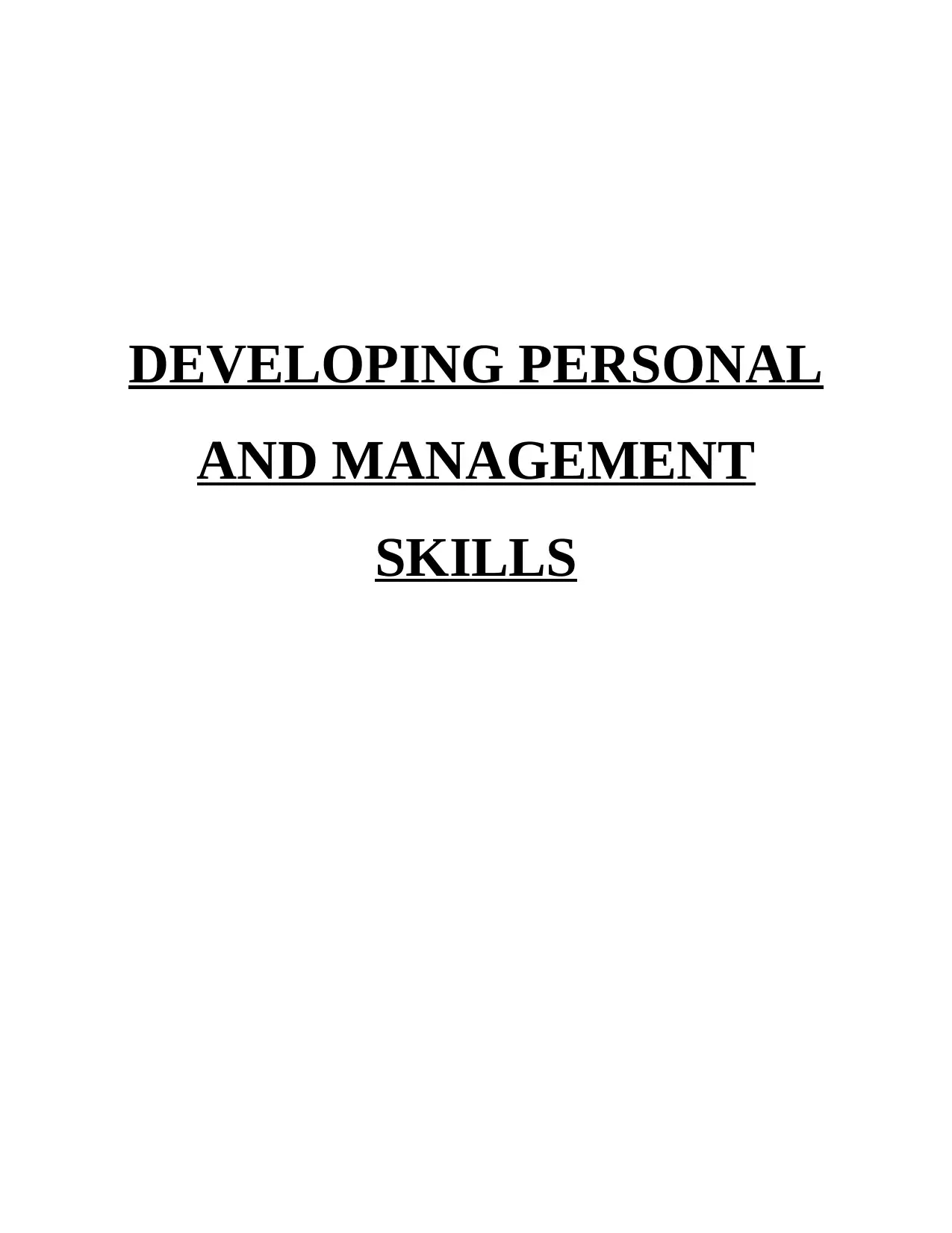
DEVELOPING PERSONAL
AND MANAGEMENT
SKILLS
AND MANAGEMENT
SKILLS
Paraphrase This Document
Need a fresh take? Get an instant paraphrase of this document with our AI Paraphraser
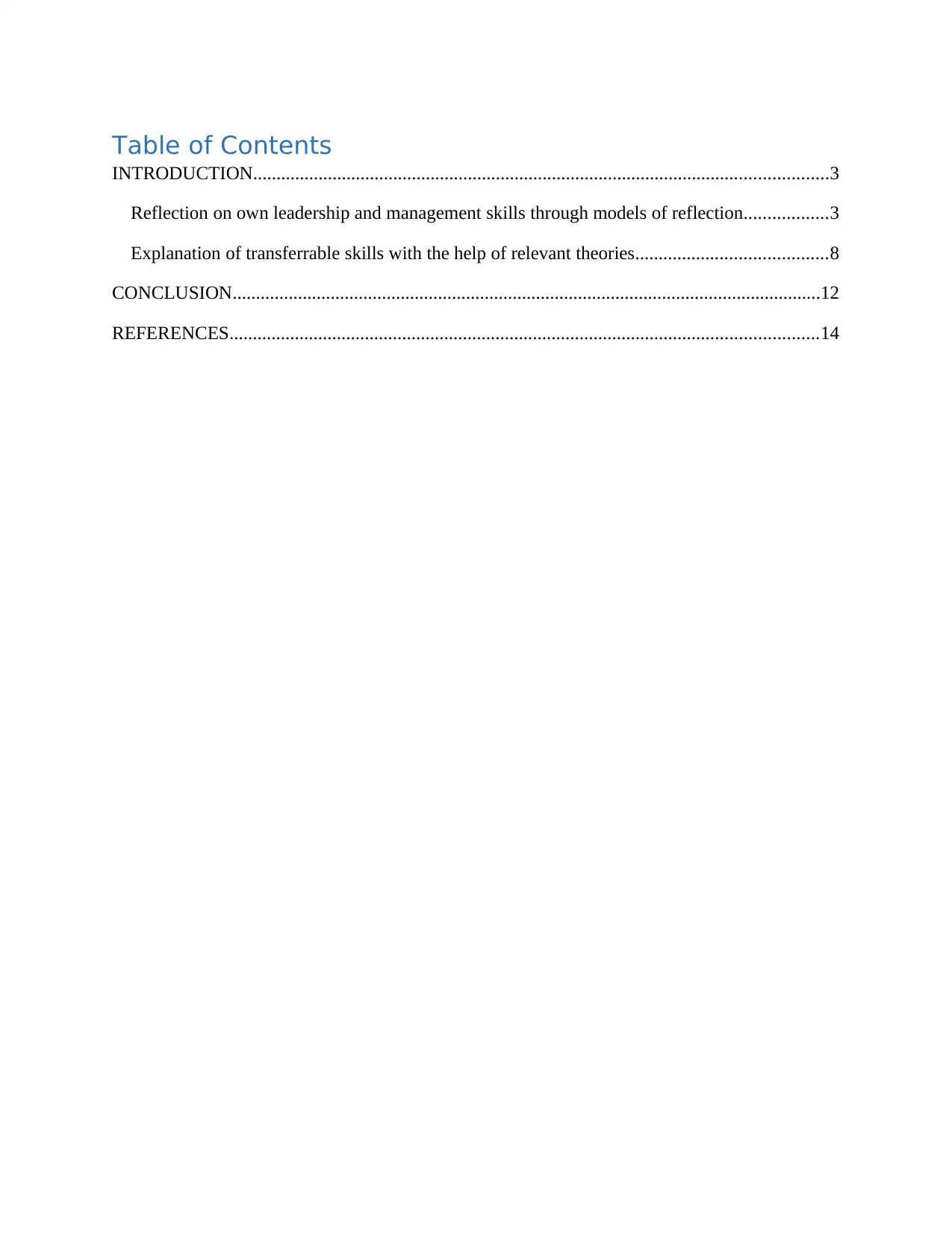
Table of Contents
INTRODUCTION...........................................................................................................................3
Reflection on own leadership and management skills through models of reflection..................3
Explanation of transferrable skills with the help of relevant theories.........................................8
CONCLUSION..............................................................................................................................12
REFERENCES..............................................................................................................................14
INTRODUCTION...........................................................................................................................3
Reflection on own leadership and management skills through models of reflection..................3
Explanation of transferrable skills with the help of relevant theories.........................................8
CONCLUSION..............................................................................................................................12
REFERENCES..............................................................................................................................14
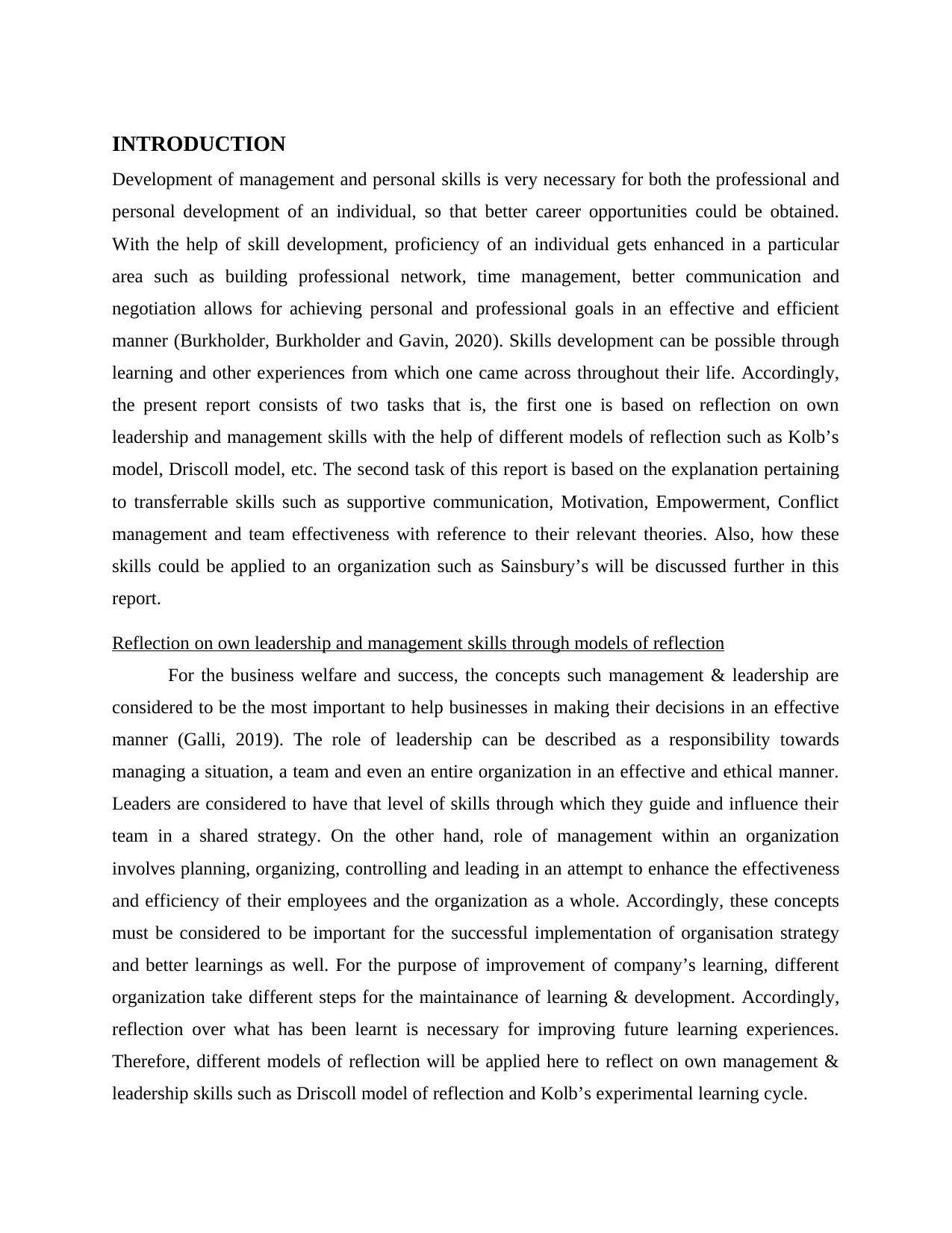
INTRODUCTION
Development of management and personal skills is very necessary for both the professional and
personal development of an individual, so that better career opportunities could be obtained.
With the help of skill development, proficiency of an individual gets enhanced in a particular
area such as building professional network, time management, better communication and
negotiation allows for achieving personal and professional goals in an effective and efficient
manner (Burkholder, Burkholder and Gavin, 2020). Skills development can be possible through
learning and other experiences from which one came across throughout their life. Accordingly,
the present report consists of two tasks that is, the first one is based on reflection on own
leadership and management skills with the help of different models of reflection such as Kolb’s
model, Driscoll model, etc. The second task of this report is based on the explanation pertaining
to transferrable skills such as supportive communication, Motivation, Empowerment, Conflict
management and team effectiveness with reference to their relevant theories. Also, how these
skills could be applied to an organization such as Sainsbury’s will be discussed further in this
report.
Reflection on own leadership and management skills through models of reflection
For the business welfare and success, the concepts such management & leadership are
considered to be the most important to help businesses in making their decisions in an effective
manner (Galli, 2019). The role of leadership can be described as a responsibility towards
managing a situation, a team and even an entire organization in an effective and ethical manner.
Leaders are considered to have that level of skills through which they guide and influence their
team in a shared strategy. On the other hand, role of management within an organization
involves planning, organizing, controlling and leading in an attempt to enhance the effectiveness
and efficiency of their employees and the organization as a whole. Accordingly, these concepts
must be considered to be important for the successful implementation of organisation strategy
and better learnings as well. For the purpose of improvement of company’s learning, different
organization take different steps for the maintainance of learning & development. Accordingly,
reflection over what has been learnt is necessary for improving future learning experiences.
Therefore, different models of reflection will be applied here to reflect on own management &
leadership skills such as Driscoll model of reflection and Kolb’s experimental learning cycle.
Development of management and personal skills is very necessary for both the professional and
personal development of an individual, so that better career opportunities could be obtained.
With the help of skill development, proficiency of an individual gets enhanced in a particular
area such as building professional network, time management, better communication and
negotiation allows for achieving personal and professional goals in an effective and efficient
manner (Burkholder, Burkholder and Gavin, 2020). Skills development can be possible through
learning and other experiences from which one came across throughout their life. Accordingly,
the present report consists of two tasks that is, the first one is based on reflection on own
leadership and management skills with the help of different models of reflection such as Kolb’s
model, Driscoll model, etc. The second task of this report is based on the explanation pertaining
to transferrable skills such as supportive communication, Motivation, Empowerment, Conflict
management and team effectiveness with reference to their relevant theories. Also, how these
skills could be applied to an organization such as Sainsbury’s will be discussed further in this
report.
Reflection on own leadership and management skills through models of reflection
For the business welfare and success, the concepts such management & leadership are
considered to be the most important to help businesses in making their decisions in an effective
manner (Galli, 2019). The role of leadership can be described as a responsibility towards
managing a situation, a team and even an entire organization in an effective and ethical manner.
Leaders are considered to have that level of skills through which they guide and influence their
team in a shared strategy. On the other hand, role of management within an organization
involves planning, organizing, controlling and leading in an attempt to enhance the effectiveness
and efficiency of their employees and the organization as a whole. Accordingly, these concepts
must be considered to be important for the successful implementation of organisation strategy
and better learnings as well. For the purpose of improvement of company’s learning, different
organization take different steps for the maintainance of learning & development. Accordingly,
reflection over what has been learnt is necessary for improving future learning experiences.
Therefore, different models of reflection will be applied here to reflect on own management &
leadership skills such as Driscoll model of reflection and Kolb’s experimental learning cycle.
⊘ This is a preview!⊘
Do you want full access?
Subscribe today to unlock all pages.

Trusted by 1+ million students worldwide
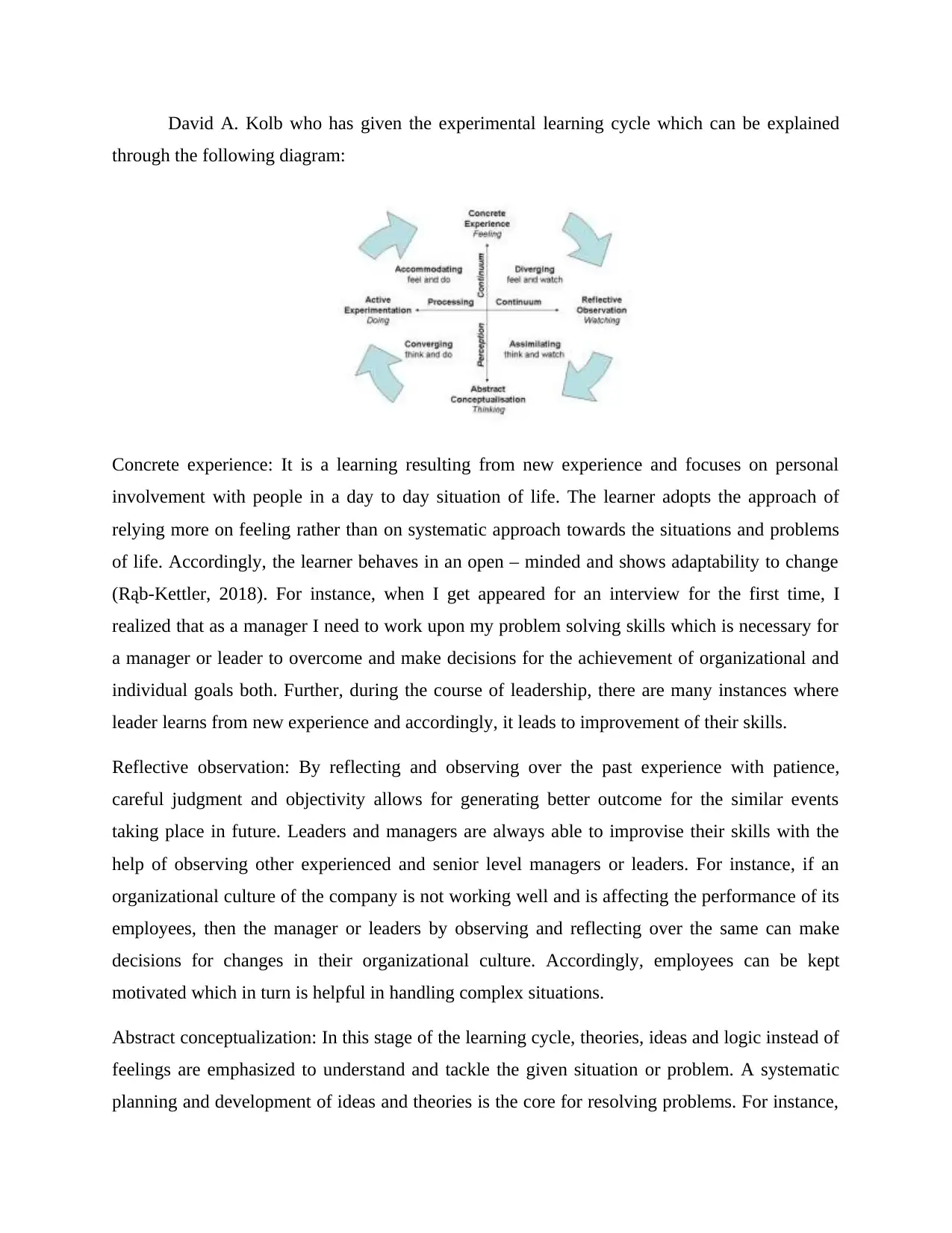
David A. Kolb who has given the experimental learning cycle which can be explained
through the following diagram:
Concrete experience: It is a learning resulting from new experience and focuses on personal
involvement with people in a day to day situation of life. The learner adopts the approach of
relying more on feeling rather than on systematic approach towards the situations and problems
of life. Accordingly, the learner behaves in an open – minded and shows adaptability to change
(Rąb-Kettler, 2018). For instance, when I get appeared for an interview for the first time, I
realized that as a manager I need to work upon my problem solving skills which is necessary for
a manager or leader to overcome and make decisions for the achievement of organizational and
individual goals both. Further, during the course of leadership, there are many instances where
leader learns from new experience and accordingly, it leads to improvement of their skills.
Reflective observation: By reflecting and observing over the past experience with patience,
careful judgment and objectivity allows for generating better outcome for the similar events
taking place in future. Leaders and managers are always able to improvise their skills with the
help of observing other experienced and senior level managers or leaders. For instance, if an
organizational culture of the company is not working well and is affecting the performance of its
employees, then the manager or leaders by observing and reflecting over the same can make
decisions for changes in their organizational culture. Accordingly, employees can be kept
motivated which in turn is helpful in handling complex situations.
Abstract conceptualization: In this stage of the learning cycle, theories, ideas and logic instead of
feelings are emphasized to understand and tackle the given situation or problem. A systematic
planning and development of ideas and theories is the core for resolving problems. For instance,
through the following diagram:
Concrete experience: It is a learning resulting from new experience and focuses on personal
involvement with people in a day to day situation of life. The learner adopts the approach of
relying more on feeling rather than on systematic approach towards the situations and problems
of life. Accordingly, the learner behaves in an open – minded and shows adaptability to change
(Rąb-Kettler, 2018). For instance, when I get appeared for an interview for the first time, I
realized that as a manager I need to work upon my problem solving skills which is necessary for
a manager or leader to overcome and make decisions for the achievement of organizational and
individual goals both. Further, during the course of leadership, there are many instances where
leader learns from new experience and accordingly, it leads to improvement of their skills.
Reflective observation: By reflecting and observing over the past experience with patience,
careful judgment and objectivity allows for generating better outcome for the similar events
taking place in future. Leaders and managers are always able to improvise their skills with the
help of observing other experienced and senior level managers or leaders. For instance, if an
organizational culture of the company is not working well and is affecting the performance of its
employees, then the manager or leaders by observing and reflecting over the same can make
decisions for changes in their organizational culture. Accordingly, employees can be kept
motivated which in turn is helpful in handling complex situations.
Abstract conceptualization: In this stage of the learning cycle, theories, ideas and logic instead of
feelings are emphasized to understand and tackle the given situation or problem. A systematic
planning and development of ideas and theories is the core for resolving problems. For instance,
Paraphrase This Document
Need a fresh take? Get an instant paraphrase of this document with our AI Paraphraser
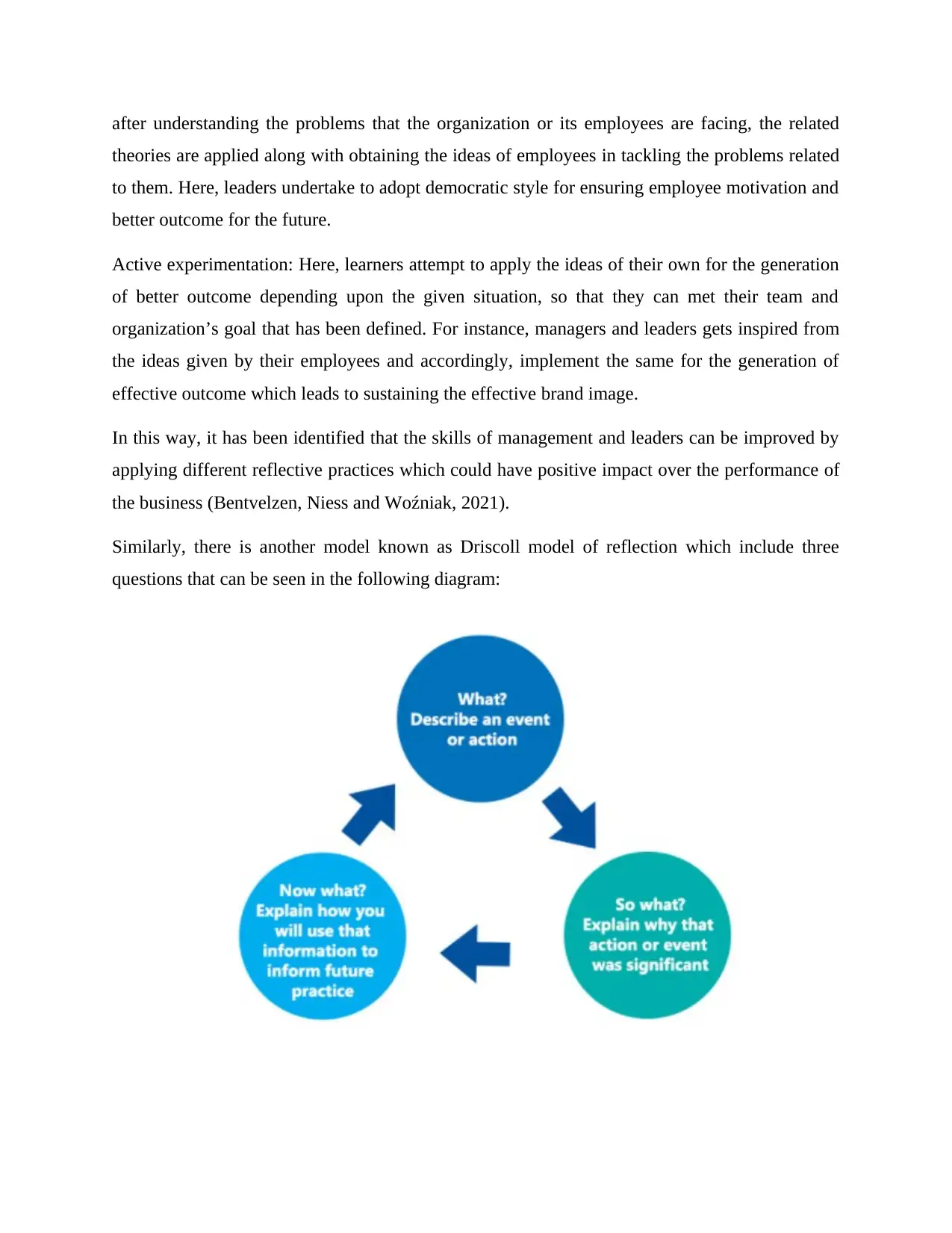
after understanding the problems that the organization or its employees are facing, the related
theories are applied along with obtaining the ideas of employees in tackling the problems related
to them. Here, leaders undertake to adopt democratic style for ensuring employee motivation and
better outcome for the future.
Active experimentation: Here, learners attempt to apply the ideas of their own for the generation
of better outcome depending upon the given situation, so that they can met their team and
organization’s goal that has been defined. For instance, managers and leaders gets inspired from
the ideas given by their employees and accordingly, implement the same for the generation of
effective outcome which leads to sustaining the effective brand image.
In this way, it has been identified that the skills of management and leaders can be improved by
applying different reflective practices which could have positive impact over the performance of
the business (Bentvelzen, Niess and Woźniak, 2021).
Similarly, there is another model known as Driscoll model of reflection which include three
questions that can be seen in the following diagram:
theories are applied along with obtaining the ideas of employees in tackling the problems related
to them. Here, leaders undertake to adopt democratic style for ensuring employee motivation and
better outcome for the future.
Active experimentation: Here, learners attempt to apply the ideas of their own for the generation
of better outcome depending upon the given situation, so that they can met their team and
organization’s goal that has been defined. For instance, managers and leaders gets inspired from
the ideas given by their employees and accordingly, implement the same for the generation of
effective outcome which leads to sustaining the effective brand image.
In this way, it has been identified that the skills of management and leaders can be improved by
applying different reflective practices which could have positive impact over the performance of
the business (Bentvelzen, Niess and Woźniak, 2021).
Similarly, there is another model known as Driscoll model of reflection which include three
questions that can be seen in the following diagram:
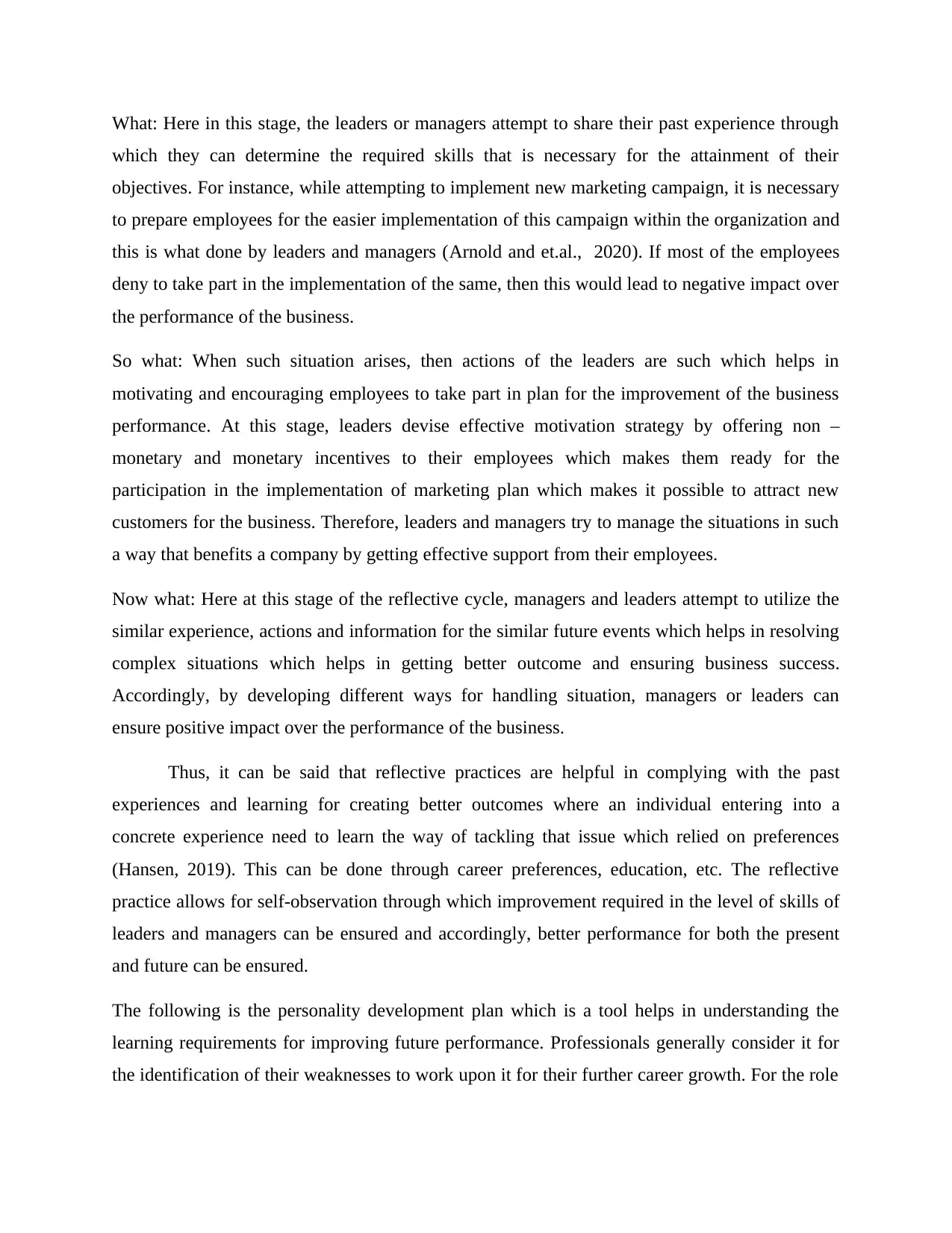
What: Here in this stage, the leaders or managers attempt to share their past experience through
which they can determine the required skills that is necessary for the attainment of their
objectives. For instance, while attempting to implement new marketing campaign, it is necessary
to prepare employees for the easier implementation of this campaign within the organization and
this is what done by leaders and managers (Arnold and et.al., 2020). If most of the employees
deny to take part in the implementation of the same, then this would lead to negative impact over
the performance of the business.
So what: When such situation arises, then actions of the leaders are such which helps in
motivating and encouraging employees to take part in plan for the improvement of the business
performance. At this stage, leaders devise effective motivation strategy by offering non –
monetary and monetary incentives to their employees which makes them ready for the
participation in the implementation of marketing plan which makes it possible to attract new
customers for the business. Therefore, leaders and managers try to manage the situations in such
a way that benefits a company by getting effective support from their employees.
Now what: Here at this stage of the reflective cycle, managers and leaders attempt to utilize the
similar experience, actions and information for the similar future events which helps in resolving
complex situations which helps in getting better outcome and ensuring business success.
Accordingly, by developing different ways for handling situation, managers or leaders can
ensure positive impact over the performance of the business.
Thus, it can be said that reflective practices are helpful in complying with the past
experiences and learning for creating better outcomes where an individual entering into a
concrete experience need to learn the way of tackling that issue which relied on preferences
(Hansen, 2019). This can be done through career preferences, education, etc. The reflective
practice allows for self-observation through which improvement required in the level of skills of
leaders and managers can be ensured and accordingly, better performance for both the present
and future can be ensured.
The following is the personality development plan which is a tool helps in understanding the
learning requirements for improving future performance. Professionals generally consider it for
the identification of their weaknesses to work upon it for their further career growth. For the role
which they can determine the required skills that is necessary for the attainment of their
objectives. For instance, while attempting to implement new marketing campaign, it is necessary
to prepare employees for the easier implementation of this campaign within the organization and
this is what done by leaders and managers (Arnold and et.al., 2020). If most of the employees
deny to take part in the implementation of the same, then this would lead to negative impact over
the performance of the business.
So what: When such situation arises, then actions of the leaders are such which helps in
motivating and encouraging employees to take part in plan for the improvement of the business
performance. At this stage, leaders devise effective motivation strategy by offering non –
monetary and monetary incentives to their employees which makes them ready for the
participation in the implementation of marketing plan which makes it possible to attract new
customers for the business. Therefore, leaders and managers try to manage the situations in such
a way that benefits a company by getting effective support from their employees.
Now what: Here at this stage of the reflective cycle, managers and leaders attempt to utilize the
similar experience, actions and information for the similar future events which helps in resolving
complex situations which helps in getting better outcome and ensuring business success.
Accordingly, by developing different ways for handling situation, managers or leaders can
ensure positive impact over the performance of the business.
Thus, it can be said that reflective practices are helpful in complying with the past
experiences and learning for creating better outcomes where an individual entering into a
concrete experience need to learn the way of tackling that issue which relied on preferences
(Hansen, 2019). This can be done through career preferences, education, etc. The reflective
practice allows for self-observation through which improvement required in the level of skills of
leaders and managers can be ensured and accordingly, better performance for both the present
and future can be ensured.
The following is the personality development plan which is a tool helps in understanding the
learning requirements for improving future performance. Professionals generally consider it for
the identification of their weaknesses to work upon it for their further career growth. For the role
⊘ This is a preview!⊘
Do you want full access?
Subscribe today to unlock all pages.

Trusted by 1+ million students worldwide
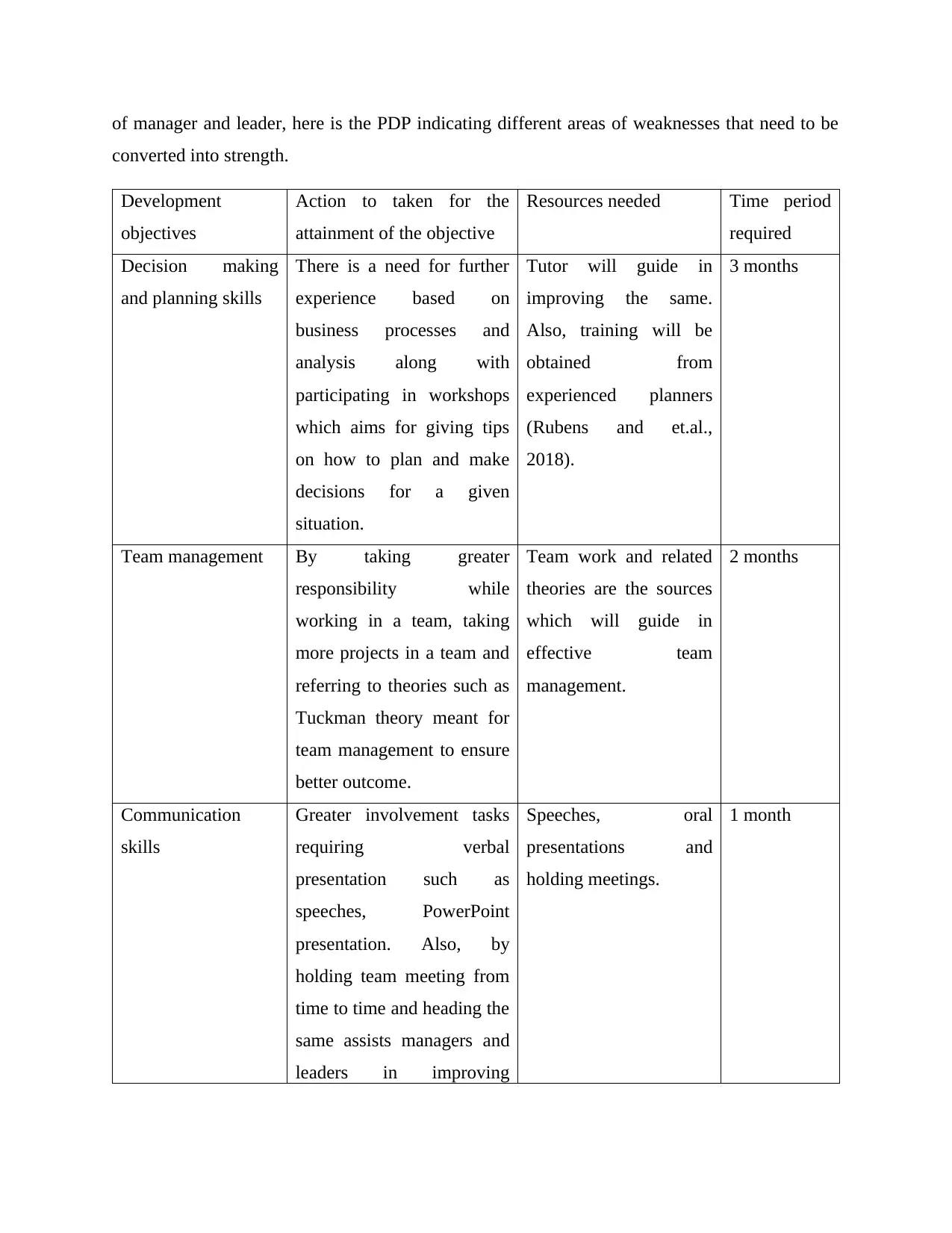
of manager and leader, here is the PDP indicating different areas of weaknesses that need to be
converted into strength.
Development
objectives
Action to taken for the
attainment of the objective
Resources needed Time period
required
Decision making
and planning skills
There is a need for further
experience based on
business processes and
analysis along with
participating in workshops
which aims for giving tips
on how to plan and make
decisions for a given
situation.
Tutor will guide in
improving the same.
Also, training will be
obtained from
experienced planners
(Rubens and et.al.,
2018).
3 months
Team management By taking greater
responsibility while
working in a team, taking
more projects in a team and
referring to theories such as
Tuckman theory meant for
team management to ensure
better outcome.
Team work and related
theories are the sources
which will guide in
effective team
management.
2 months
Communication
skills
Greater involvement tasks
requiring verbal
presentation such as
speeches, PowerPoint
presentation. Also, by
holding team meeting from
time to time and heading the
same assists managers and
leaders in improving
Speeches, oral
presentations and
holding meetings.
1 month
converted into strength.
Development
objectives
Action to taken for the
attainment of the objective
Resources needed Time period
required
Decision making
and planning skills
There is a need for further
experience based on
business processes and
analysis along with
participating in workshops
which aims for giving tips
on how to plan and make
decisions for a given
situation.
Tutor will guide in
improving the same.
Also, training will be
obtained from
experienced planners
(Rubens and et.al.,
2018).
3 months
Team management By taking greater
responsibility while
working in a team, taking
more projects in a team and
referring to theories such as
Tuckman theory meant for
team management to ensure
better outcome.
Team work and related
theories are the sources
which will guide in
effective team
management.
2 months
Communication
skills
Greater involvement tasks
requiring verbal
presentation such as
speeches, PowerPoint
presentation. Also, by
holding team meeting from
time to time and heading the
same assists managers and
leaders in improving
Speeches, oral
presentations and
holding meetings.
1 month
Paraphrase This Document
Need a fresh take? Get an instant paraphrase of this document with our AI Paraphraser
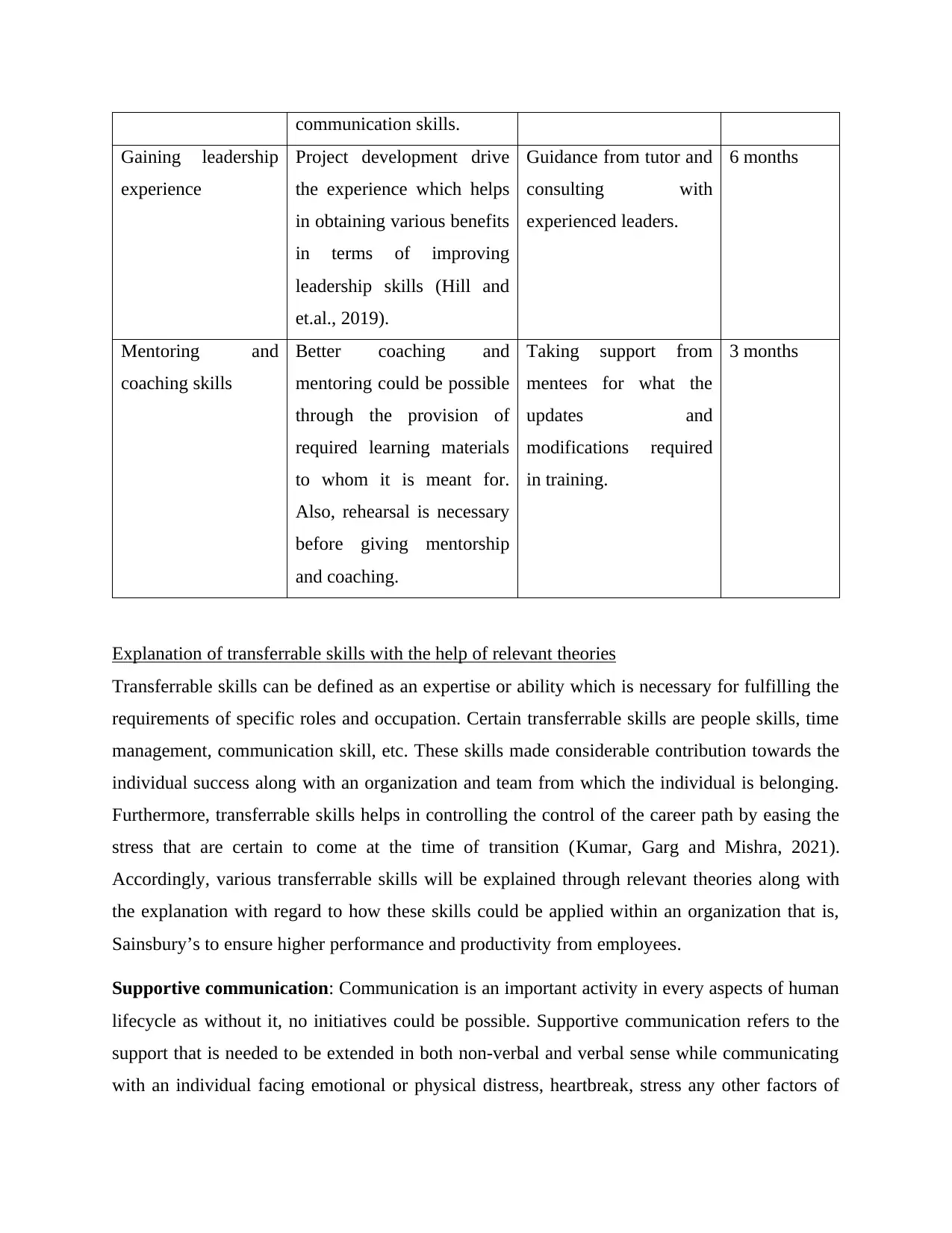
communication skills.
Gaining leadership
experience
Project development drive
the experience which helps
in obtaining various benefits
in terms of improving
leadership skills (Hill and
et.al., 2019).
Guidance from tutor and
consulting with
experienced leaders.
6 months
Mentoring and
coaching skills
Better coaching and
mentoring could be possible
through the provision of
required learning materials
to whom it is meant for.
Also, rehearsal is necessary
before giving mentorship
and coaching.
Taking support from
mentees for what the
updates and
modifications required
in training.
3 months
Explanation of transferrable skills with the help of relevant theories
Transferrable skills can be defined as an expertise or ability which is necessary for fulfilling the
requirements of specific roles and occupation. Certain transferrable skills are people skills, time
management, communication skill, etc. These skills made considerable contribution towards the
individual success along with an organization and team from which the individual is belonging.
Furthermore, transferrable skills helps in controlling the control of the career path by easing the
stress that are certain to come at the time of transition (Kumar, Garg and Mishra, 2021).
Accordingly, various transferrable skills will be explained through relevant theories along with
the explanation with regard to how these skills could be applied within an organization that is,
Sainsbury’s to ensure higher performance and productivity from employees.
Supportive communication: Communication is an important activity in every aspects of human
lifecycle as without it, no initiatives could be possible. Supportive communication refers to the
support that is needed to be extended in both non-verbal and verbal sense while communicating
with an individual facing emotional or physical distress, heartbreak, stress any other factors of
Gaining leadership
experience
Project development drive
the experience which helps
in obtaining various benefits
in terms of improving
leadership skills (Hill and
et.al., 2019).
Guidance from tutor and
consulting with
experienced leaders.
6 months
Mentoring and
coaching skills
Better coaching and
mentoring could be possible
through the provision of
required learning materials
to whom it is meant for.
Also, rehearsal is necessary
before giving mentorship
and coaching.
Taking support from
mentees for what the
updates and
modifications required
in training.
3 months
Explanation of transferrable skills with the help of relevant theories
Transferrable skills can be defined as an expertise or ability which is necessary for fulfilling the
requirements of specific roles and occupation. Certain transferrable skills are people skills, time
management, communication skill, etc. These skills made considerable contribution towards the
individual success along with an organization and team from which the individual is belonging.
Furthermore, transferrable skills helps in controlling the control of the career path by easing the
stress that are certain to come at the time of transition (Kumar, Garg and Mishra, 2021).
Accordingly, various transferrable skills will be explained through relevant theories along with
the explanation with regard to how these skills could be applied within an organization that is,
Sainsbury’s to ensure higher performance and productivity from employees.
Supportive communication: Communication is an important activity in every aspects of human
lifecycle as without it, no initiatives could be possible. Supportive communication refers to the
support that is needed to be extended in both non-verbal and verbal sense while communicating
with an individual facing emotional or physical distress, heartbreak, stress any other factors of
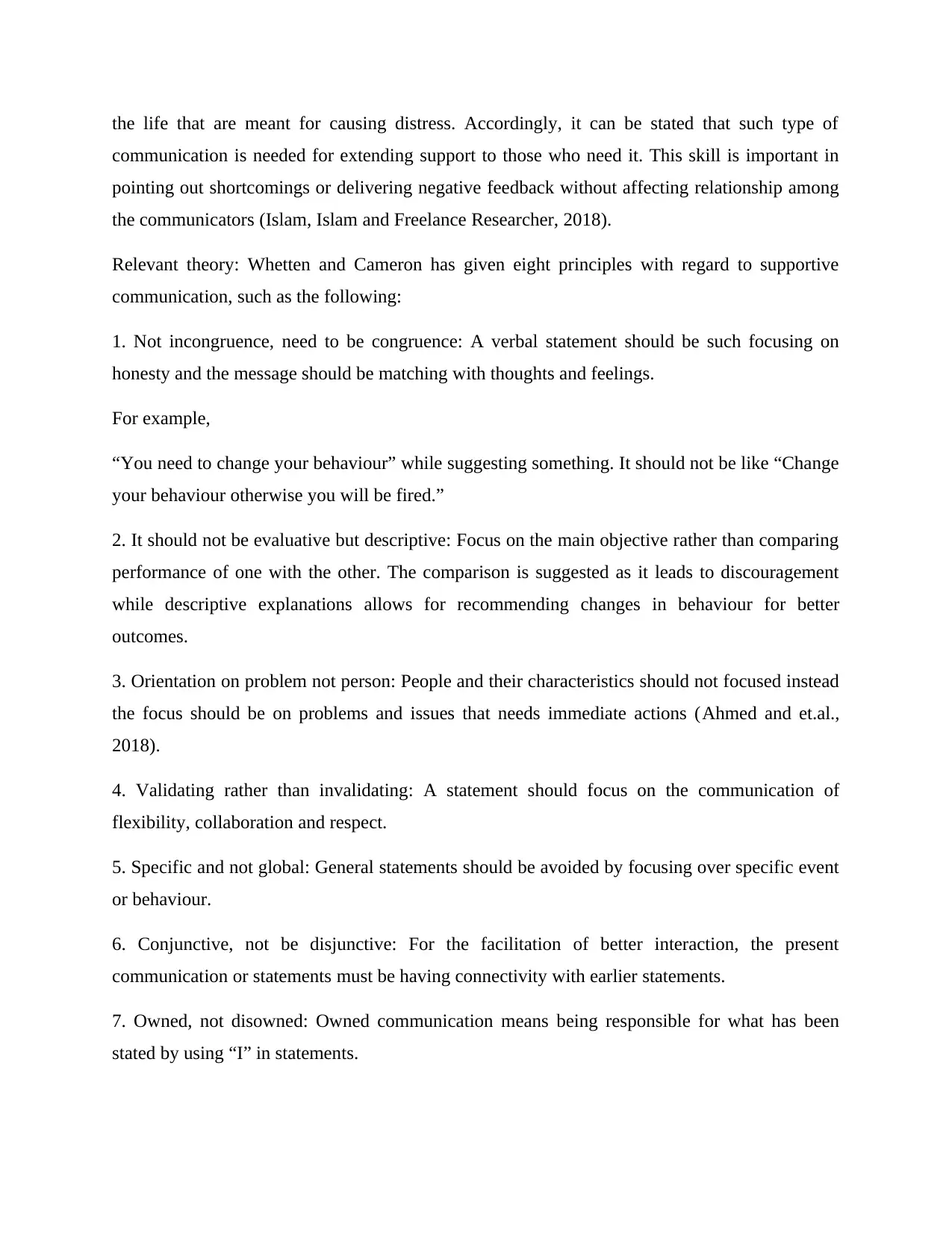
the life that are meant for causing distress. Accordingly, it can be stated that such type of
communication is needed for extending support to those who need it. This skill is important in
pointing out shortcomings or delivering negative feedback without affecting relationship among
the communicators (Islam, Islam and Freelance Researcher, 2018).
Relevant theory: Whetten and Cameron has given eight principles with regard to supportive
communication, such as the following:
1. Not incongruence, need to be congruence: A verbal statement should be such focusing on
honesty and the message should be matching with thoughts and feelings.
For example,
“You need to change your behaviour” while suggesting something. It should not be like “Change
your behaviour otherwise you will be fired.”
2. It should not be evaluative but descriptive: Focus on the main objective rather than comparing
performance of one with the other. The comparison is suggested as it leads to discouragement
while descriptive explanations allows for recommending changes in behaviour for better
outcomes.
3. Orientation on problem not person: People and their characteristics should not focused instead
the focus should be on problems and issues that needs immediate actions (Ahmed and et.al.,
2018).
4. Validating rather than invalidating: A statement should focus on the communication of
flexibility, collaboration and respect.
5. Specific and not global: General statements should be avoided by focusing over specific event
or behaviour.
6. Conjunctive, not be disjunctive: For the facilitation of better interaction, the present
communication or statements must be having connectivity with earlier statements.
7. Owned, not disowned: Owned communication means being responsible for what has been
stated by using “I” in statements.
communication is needed for extending support to those who need it. This skill is important in
pointing out shortcomings or delivering negative feedback without affecting relationship among
the communicators (Islam, Islam and Freelance Researcher, 2018).
Relevant theory: Whetten and Cameron has given eight principles with regard to supportive
communication, such as the following:
1. Not incongruence, need to be congruence: A verbal statement should be such focusing on
honesty and the message should be matching with thoughts and feelings.
For example,
“You need to change your behaviour” while suggesting something. It should not be like “Change
your behaviour otherwise you will be fired.”
2. It should not be evaluative but descriptive: Focus on the main objective rather than comparing
performance of one with the other. The comparison is suggested as it leads to discouragement
while descriptive explanations allows for recommending changes in behaviour for better
outcomes.
3. Orientation on problem not person: People and their characteristics should not focused instead
the focus should be on problems and issues that needs immediate actions (Ahmed and et.al.,
2018).
4. Validating rather than invalidating: A statement should focus on the communication of
flexibility, collaboration and respect.
5. Specific and not global: General statements should be avoided by focusing over specific event
or behaviour.
6. Conjunctive, not be disjunctive: For the facilitation of better interaction, the present
communication or statements must be having connectivity with earlier statements.
7. Owned, not disowned: Owned communication means being responsible for what has been
stated by using “I” in statements.
⊘ This is a preview!⊘
Do you want full access?
Subscribe today to unlock all pages.

Trusted by 1+ million students worldwide
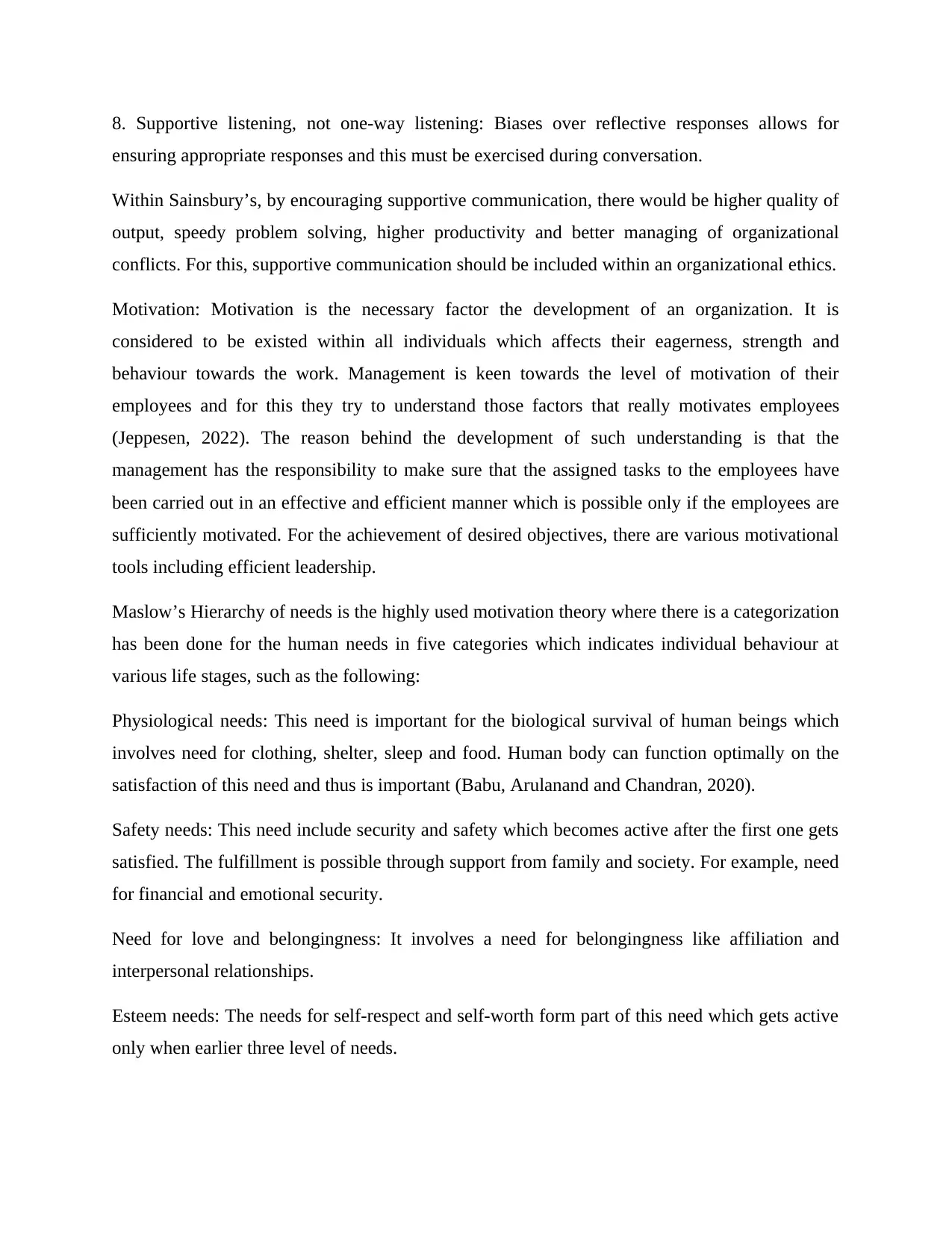
8. Supportive listening, not one-way listening: Biases over reflective responses allows for
ensuring appropriate responses and this must be exercised during conversation.
Within Sainsbury’s, by encouraging supportive communication, there would be higher quality of
output, speedy problem solving, higher productivity and better managing of organizational
conflicts. For this, supportive communication should be included within an organizational ethics.
Motivation: Motivation is the necessary factor the development of an organization. It is
considered to be existed within all individuals which affects their eagerness, strength and
behaviour towards the work. Management is keen towards the level of motivation of their
employees and for this they try to understand those factors that really motivates employees
(Jeppesen, 2022). The reason behind the development of such understanding is that the
management has the responsibility to make sure that the assigned tasks to the employees have
been carried out in an effective and efficient manner which is possible only if the employees are
sufficiently motivated. For the achievement of desired objectives, there are various motivational
tools including efficient leadership.
Maslow’s Hierarchy of needs is the highly used motivation theory where there is a categorization
has been done for the human needs in five categories which indicates individual behaviour at
various life stages, such as the following:
Physiological needs: This need is important for the biological survival of human beings which
involves need for clothing, shelter, sleep and food. Human body can function optimally on the
satisfaction of this need and thus is important (Babu, Arulanand and Chandran, 2020).
Safety needs: This need include security and safety which becomes active after the first one gets
satisfied. The fulfillment is possible through support from family and society. For example, need
for financial and emotional security.
Need for love and belongingness: It involves a need for belongingness like affiliation and
interpersonal relationships.
Esteem needs: The needs for self-respect and self-worth form part of this need which gets active
only when earlier three level of needs.
ensuring appropriate responses and this must be exercised during conversation.
Within Sainsbury’s, by encouraging supportive communication, there would be higher quality of
output, speedy problem solving, higher productivity and better managing of organizational
conflicts. For this, supportive communication should be included within an organizational ethics.
Motivation: Motivation is the necessary factor the development of an organization. It is
considered to be existed within all individuals which affects their eagerness, strength and
behaviour towards the work. Management is keen towards the level of motivation of their
employees and for this they try to understand those factors that really motivates employees
(Jeppesen, 2022). The reason behind the development of such understanding is that the
management has the responsibility to make sure that the assigned tasks to the employees have
been carried out in an effective and efficient manner which is possible only if the employees are
sufficiently motivated. For the achievement of desired objectives, there are various motivational
tools including efficient leadership.
Maslow’s Hierarchy of needs is the highly used motivation theory where there is a categorization
has been done for the human needs in five categories which indicates individual behaviour at
various life stages, such as the following:
Physiological needs: This need is important for the biological survival of human beings which
involves need for clothing, shelter, sleep and food. Human body can function optimally on the
satisfaction of this need and thus is important (Babu, Arulanand and Chandran, 2020).
Safety needs: This need include security and safety which becomes active after the first one gets
satisfied. The fulfillment is possible through support from family and society. For example, need
for financial and emotional security.
Need for love and belongingness: It involves a need for belongingness like affiliation and
interpersonal relationships.
Esteem needs: The needs for self-respect and self-worth form part of this need which gets active
only when earlier three level of needs.
Paraphrase This Document
Need a fresh take? Get an instant paraphrase of this document with our AI Paraphraser
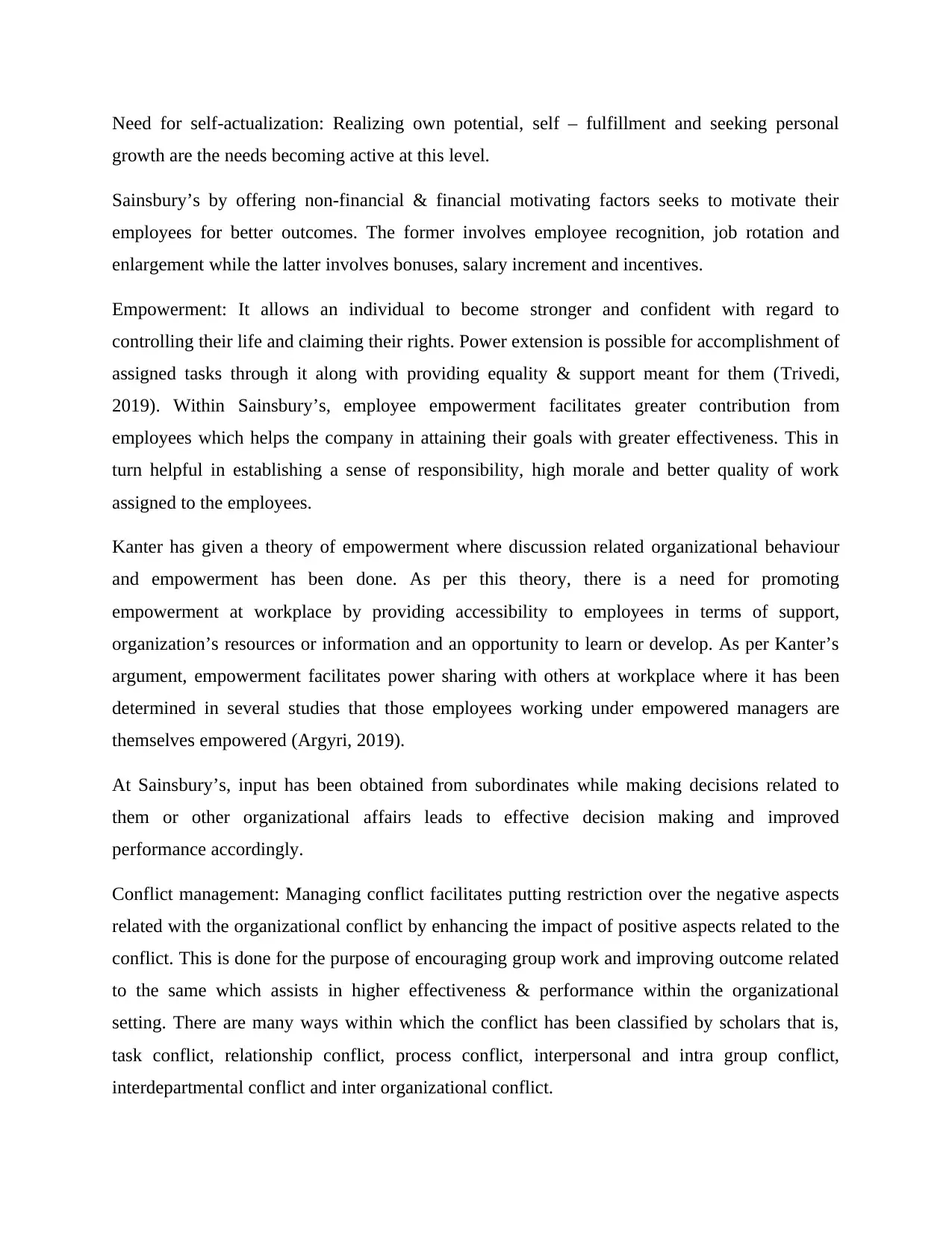
Need for self-actualization: Realizing own potential, self – fulfillment and seeking personal
growth are the needs becoming active at this level.
Sainsbury’s by offering non-financial & financial motivating factors seeks to motivate their
employees for better outcomes. The former involves employee recognition, job rotation and
enlargement while the latter involves bonuses, salary increment and incentives.
Empowerment: It allows an individual to become stronger and confident with regard to
controlling their life and claiming their rights. Power extension is possible for accomplishment of
assigned tasks through it along with providing equality & support meant for them (Trivedi,
2019). Within Sainsbury’s, employee empowerment facilitates greater contribution from
employees which helps the company in attaining their goals with greater effectiveness. This in
turn helpful in establishing a sense of responsibility, high morale and better quality of work
assigned to the employees.
Kanter has given a theory of empowerment where discussion related organizational behaviour
and empowerment has been done. As per this theory, there is a need for promoting
empowerment at workplace by providing accessibility to employees in terms of support,
organization’s resources or information and an opportunity to learn or develop. As per Kanter’s
argument, empowerment facilitates power sharing with others at workplace where it has been
determined in several studies that those employees working under empowered managers are
themselves empowered (Argyri, 2019).
At Sainsbury’s, input has been obtained from subordinates while making decisions related to
them or other organizational affairs leads to effective decision making and improved
performance accordingly.
Conflict management: Managing conflict facilitates putting restriction over the negative aspects
related with the organizational conflict by enhancing the impact of positive aspects related to the
conflict. This is done for the purpose of encouraging group work and improving outcome related
to the same which assists in higher effectiveness & performance within the organizational
setting. There are many ways within which the conflict has been classified by scholars that is,
task conflict, relationship conflict, process conflict, interpersonal and intra group conflict,
interdepartmental conflict and inter organizational conflict.
growth are the needs becoming active at this level.
Sainsbury’s by offering non-financial & financial motivating factors seeks to motivate their
employees for better outcomes. The former involves employee recognition, job rotation and
enlargement while the latter involves bonuses, salary increment and incentives.
Empowerment: It allows an individual to become stronger and confident with regard to
controlling their life and claiming their rights. Power extension is possible for accomplishment of
assigned tasks through it along with providing equality & support meant for them (Trivedi,
2019). Within Sainsbury’s, employee empowerment facilitates greater contribution from
employees which helps the company in attaining their goals with greater effectiveness. This in
turn helpful in establishing a sense of responsibility, high morale and better quality of work
assigned to the employees.
Kanter has given a theory of empowerment where discussion related organizational behaviour
and empowerment has been done. As per this theory, there is a need for promoting
empowerment at workplace by providing accessibility to employees in terms of support,
organization’s resources or information and an opportunity to learn or develop. As per Kanter’s
argument, empowerment facilitates power sharing with others at workplace where it has been
determined in several studies that those employees working under empowered managers are
themselves empowered (Argyri, 2019).
At Sainsbury’s, input has been obtained from subordinates while making decisions related to
them or other organizational affairs leads to effective decision making and improved
performance accordingly.
Conflict management: Managing conflict facilitates putting restriction over the negative aspects
related with the organizational conflict by enhancing the impact of positive aspects related to the
conflict. This is done for the purpose of encouraging group work and improving outcome related
to the same which assists in higher effectiveness & performance within the organizational
setting. There are many ways within which the conflict has been classified by scholars that is,
task conflict, relationship conflict, process conflict, interpersonal and intra group conflict,
interdepartmental conflict and inter organizational conflict.
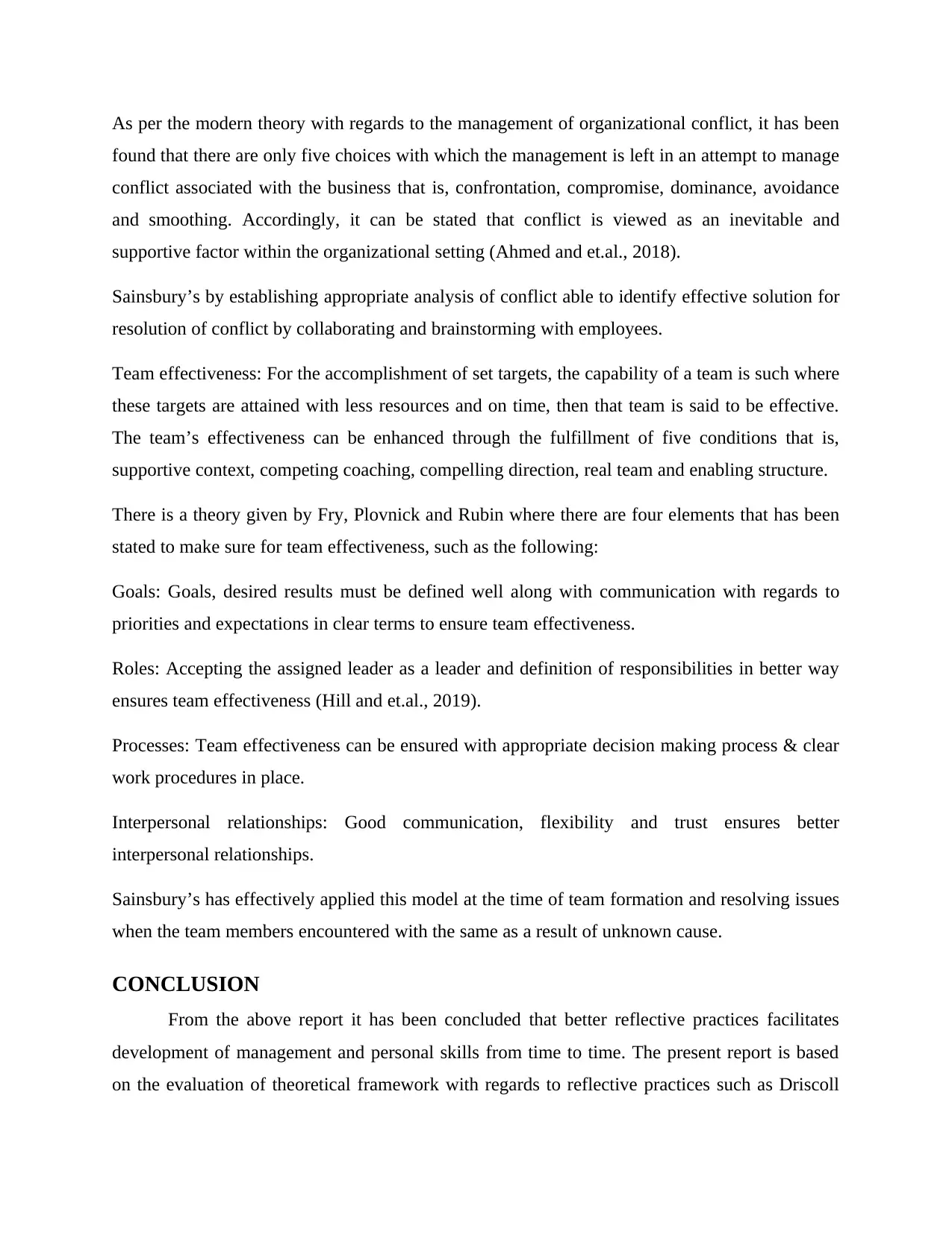
As per the modern theory with regards to the management of organizational conflict, it has been
found that there are only five choices with which the management is left in an attempt to manage
conflict associated with the business that is, confrontation, compromise, dominance, avoidance
and smoothing. Accordingly, it can be stated that conflict is viewed as an inevitable and
supportive factor within the organizational setting (Ahmed and et.al., 2018).
Sainsbury’s by establishing appropriate analysis of conflict able to identify effective solution for
resolution of conflict by collaborating and brainstorming with employees.
Team effectiveness: For the accomplishment of set targets, the capability of a team is such where
these targets are attained with less resources and on time, then that team is said to be effective.
The team’s effectiveness can be enhanced through the fulfillment of five conditions that is,
supportive context, competing coaching, compelling direction, real team and enabling structure.
There is a theory given by Fry, Plovnick and Rubin where there are four elements that has been
stated to make sure for team effectiveness, such as the following:
Goals: Goals, desired results must be defined well along with communication with regards to
priorities and expectations in clear terms to ensure team effectiveness.
Roles: Accepting the assigned leader as a leader and definition of responsibilities in better way
ensures team effectiveness (Hill and et.al., 2019).
Processes: Team effectiveness can be ensured with appropriate decision making process & clear
work procedures in place.
Interpersonal relationships: Good communication, flexibility and trust ensures better
interpersonal relationships.
Sainsbury’s has effectively applied this model at the time of team formation and resolving issues
when the team members encountered with the same as a result of unknown cause.
CONCLUSION
From the above report it has been concluded that better reflective practices facilitates
development of management and personal skills from time to time. The present report is based
on the evaluation of theoretical framework with regards to reflective practices such as Driscoll
found that there are only five choices with which the management is left in an attempt to manage
conflict associated with the business that is, confrontation, compromise, dominance, avoidance
and smoothing. Accordingly, it can be stated that conflict is viewed as an inevitable and
supportive factor within the organizational setting (Ahmed and et.al., 2018).
Sainsbury’s by establishing appropriate analysis of conflict able to identify effective solution for
resolution of conflict by collaborating and brainstorming with employees.
Team effectiveness: For the accomplishment of set targets, the capability of a team is such where
these targets are attained with less resources and on time, then that team is said to be effective.
The team’s effectiveness can be enhanced through the fulfillment of five conditions that is,
supportive context, competing coaching, compelling direction, real team and enabling structure.
There is a theory given by Fry, Plovnick and Rubin where there are four elements that has been
stated to make sure for team effectiveness, such as the following:
Goals: Goals, desired results must be defined well along with communication with regards to
priorities and expectations in clear terms to ensure team effectiveness.
Roles: Accepting the assigned leader as a leader and definition of responsibilities in better way
ensures team effectiveness (Hill and et.al., 2019).
Processes: Team effectiveness can be ensured with appropriate decision making process & clear
work procedures in place.
Interpersonal relationships: Good communication, flexibility and trust ensures better
interpersonal relationships.
Sainsbury’s has effectively applied this model at the time of team formation and resolving issues
when the team members encountered with the same as a result of unknown cause.
CONCLUSION
From the above report it has been concluded that better reflective practices facilitates
development of management and personal skills from time to time. The present report is based
on the evaluation of theoretical framework with regards to reflective practices such as Driscoll
⊘ This is a preview!⊘
Do you want full access?
Subscribe today to unlock all pages.

Trusted by 1+ million students worldwide
1 out of 15
Related Documents
Your All-in-One AI-Powered Toolkit for Academic Success.
+13062052269
info@desklib.com
Available 24*7 on WhatsApp / Email
![[object Object]](/_next/static/media/star-bottom.7253800d.svg)
Unlock your academic potential
Copyright © 2020–2025 A2Z Services. All Rights Reserved. Developed and managed by ZUCOL.




